SIM Inflation Plus Fund Tests The Brakes

Philip Liebenberg, Head of Absolute Returns, Sanlam Investment Management (from 2009 – April 2017). The SIM Inflation Plus Fund is currently managed by Natasha Narsingh, Head of Absolute Return, Sanlam Investments.
May is notorious for market corrections and 2015 was no exception. The All Share Index lost 4% during the month, while property fell 6%. Many investors experienced the see-saw ride of asset fluctuations during May – but not those invested in the Sanlam Investment Management (SIM) Inflation Plus Fund.
Although markets declined, the fund managed to produce a positive return and protect capital for our clients, displaying its true-to-label defensive nature.
Capital protection over one-year periods
The aim of the fund is to avoid large negative returns. Since 2009, investors have been fortunate to not have experienced any negative rolling one-year returns.
Liebenberg points out, “Capital protection is a key objective of the fund. We differentiate ourselves in that respect.”
Since Liebenberg has taken over the management of the fund, it has delivered a positive return for all 66 of the rolling one-year periods until May 2015.
The fund is now in the right stable
The SIM Inflation Plus Fund is a cautiously managed absolute return fund that has consistently been protecting investors from the whims of the market, while delivering attractive real returns. It currently holds a PlexCrown Fund Rating of 5, the highest score, awarded only to funds with competitive returns generated with much less volatility than that of their competitors. This was partly achieved by limiting the fund’s net (hedged) exposure to shares.
We are very pleased that ASISA has approved the move of the SIM Inflation Plus Fund from the SA Multi Asset Medium Equity category to the SA Multi Asset Low Equity category, which means that it is now mandated to invest no more than 40% in shares, down from the 60% cap when it was still in the Medium Equity Category. This is a much for accurate reflection of the historical asset allocation of the fund.
“This is in line with how we‘ve been managing this fund for many years – generally defensively”, says Liebenberg, who manages the fund with Gerhard Cruywagen. “So, the re-classification has no impact on our investment process. It simply reflects what we’ve been doing all along.”
How does the fund fare relative to its Low Equity peers?
In terms of protection relative to peers, the SIM Inflation Plus Fund has displayed superior downside protection relative to the other funds in the ASISA SA Multi Asset Low Equity category. This is illustrated in the charts below.
On a monthly return basis, the fund not only delivered a higher number of positive periods than its main competitors, but also a lower number of negative periods.
This means that not only is the fund excellent at handling market corrections, but clients still get the benefits of upside when markets are trending upwards.
As shown in the chart below, on a risk/return basis over the past two years, the SIM Inflation Plus Fund has offered excellent risk-adjusted returns relative to its peers.
How sensitive is the fund to interest rate changes?
The FTSE/JSE All Share Index (ALSI) has a strong inverse relationship to bond rates. When rates go up, the ALSI tends to fall. To investigate exactly how sensitive the SIM Inflation Plus Fund is to interest rate changes, we looked at the biggest four monthly 10-year bond rate movements over the past two years: June 2013 (rates up), January 2014 (rates up again), February 2015 (rates down) and May 2015 (rates up). The four charts below show that the fund is significantly less susceptible to rate changes than its main competitors in the SA Multi Asset Low Equity category.
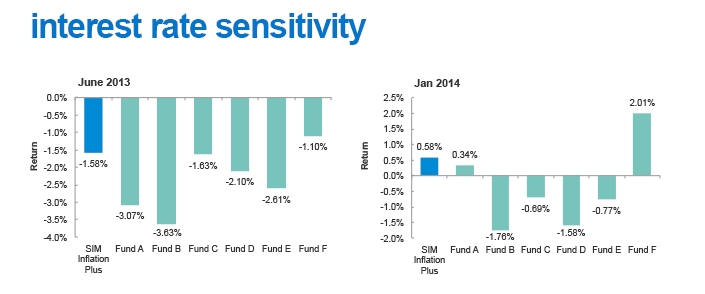
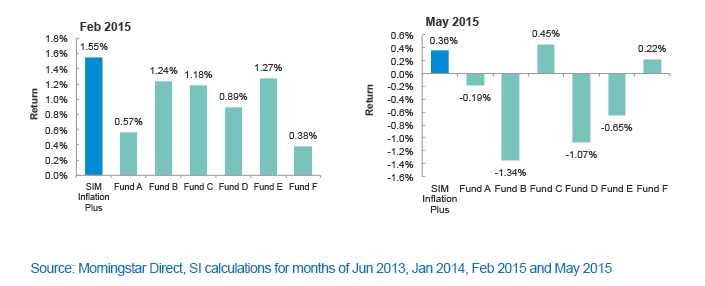
How is the fund managed?
- It’s a flexible (not strategic) asset allocation fund that aims to deliver smooth, positive real returns.
- Downside risk is managed through:
- diversification across asset classes (local and offshore); and
- the explicit use of derivatives to protect capital over any 12-month period.
- The portfolio managers consider the risk/return budget of every single asset position in the fund.
A word of caution
Liebenberg warns against unrealistic expectations. “The SA stock market has corrected, but is still expensive. The SIM Inflation Plus Fund is therefore partly hedged out of SA equities.”
All in all, investors should not expect the fund to beat inflation by much more than CPI + 4% over the next three years. Still, the fund remains a good solution for investors who desire a good balance between income and growth, and explicit downside protection.”
Download the fund’s minimum disclosure document here.
Mandatory disclosure
All information and opinions provided are of a general nature and are not intended to address the circumstances of any particular individual or entity. We are not acting and do not purport to act in any way as an advisor or in a fiduciary capacity. No one should act upon such information or opinion without appropriate advice after a thorough examination of a particular situation. We endeavor to provide accurate and timely information but make no representation or warranty, express or implied, with respect to the correctness, accuracy or completeness of the information or opinions. Any representation or opinion is provided for information purposes only. Unit trusts are generally medium to long-term investments. Past performance of the investment in no guarantee of future returns. Unit trusts are traded at a ruling price and can engage in borrowing and scrip lending. Sanlam Investments consists of the following authorised Financial Services Providers: Sanlam Investment Management (Pty) Ltd (“SIM”), Sanlam Multi Manager International (Pty) Ltd (“SMMI”), Satrix Managers (RF) (Pty) Ltd, Graviton Wealth Management (Pty) Ltd (“GWM”), Graviton Financial Partners (Pty) Ltd (“GFP”), Radius Administrative Services (Pty) Ltd (“Radius”), Blue Ink Investments (Pty) Ltd (“Blue Ink”), Sanlam Capital Markets (Pty) Ltd (“SCM”), Sanlam Private Wealth (Pty) Ltd (“SPW”) and Sanlam Employee Benefits (Pty) Ltd (“SEB”), a division of Sanlam Life Insurance Limited; and has the following approved Management Companies under the Collective Investment Schemes Control Act: Sanlam Collective Investments (RF) (Pty) Ltd (“SCI”) and Satrix Managers (RF) (Pty) Ltd (“Satrix”). Although all reasonable steps have been taken to ensure the information in this document is accurate, Sanlam Collective Investments (RF) (Pty) Ltd (“Sanlam Collective Investments”) does not accept any responsibility for any claim, damages, loss or expense; however it arises, out of or in connection with the information. No member of Sanlam gives any representation, warranty or undertaking, nor accepts any responsibility or liability as to the accuracy of any of this information. The information to follow does not constitute financial advice as contemplated in terms of the Financial Advisory and Intermediary Services Act. Use or rely on this information at your own risk. Independent professional financial advice should always be sought before making an investment decision. Sanlam Group is a full member of the Association for Savings and Investment SA (ASISA). Collective investment schemes are generally medium- to long-term investments. Please note that past performances are not necessarily an accurate determination of future performances, and that the value of investments may go down as well as up. A schedule of fees and charges and maximum commissions is available from the Manager, Sanlam Collective Investments, a registered and approved Manager in Collective Investment Schemes in Securities. Additional information of the proposed investment, including brochures, application forms and annual or quarterly reports, can be obtained from the Manager, free of charge. Collective investments are traded at ruling prices and can engage in borrowing and scrip lending. Collective investments are calculated on a net asset value basis, which is the total market value of all assets in the portfolio including any income accruals and less any deductible expenses such as audit fees, brokerage and service fees. Actual investment performance of the portfolio and the investor will differ depending on the initial fees applicable, the actual investment date, and the date of reinvestment of income as well as dividend withholding tax. Forward pricing is used. The Manager does not provide any guarantee either with respect to the capital or the return of a portfolio. The performance of the portfolio depends on the underlying assets and variable market factors. Performance is based on NAV to NAV calculations with income reinvestments done on the ex-div date. Lump sum investment performances are quoted. The portfolio may invest in other unit trust portfolios which levy their own fees, and may result is a higher fee structure for our portfolio. All the portfolio options presented are approved collective investment schemes in terms of Collective Investment Schemes Control Act, No 45 of 2002. International investments or investments in foreign securities could be accompanied by additional risks such as potential constraints on liquidity and repatriation of funds, macroeconomic risk, political risk, foreign exchange risk, tax risk, settlement risk as well as potential limitations on the availability of market information. The Manager has the right to close any portfolios to new investors to manage them more efficiently in accordance with their mandates. The portfolio management of all the portfolios is outsourced to financial services providers authorized in terms of the Financial Advisory and Intermediary Services Act, 2002. Standard Bank of South Africa Ltd is the appointed trustee of the Sanlam Collective Investments Scheme.

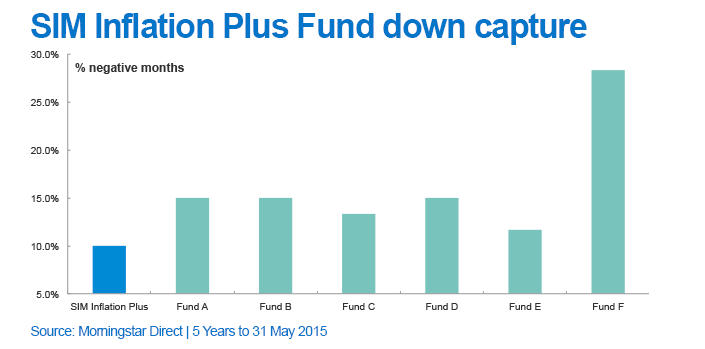
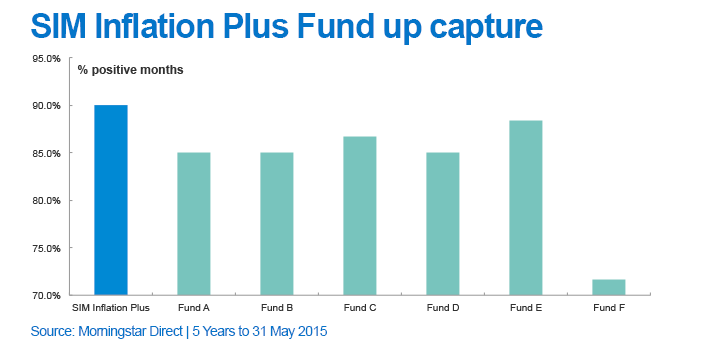
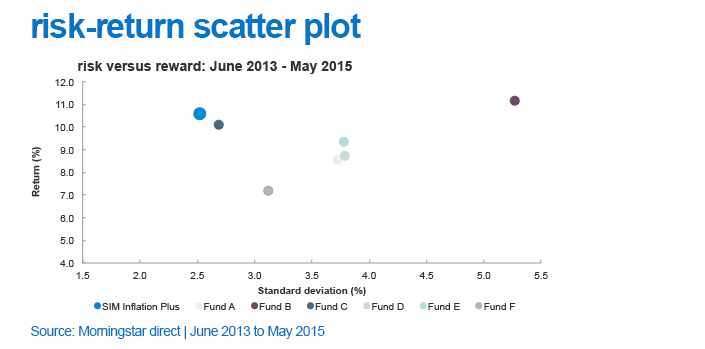




Comments are closed.